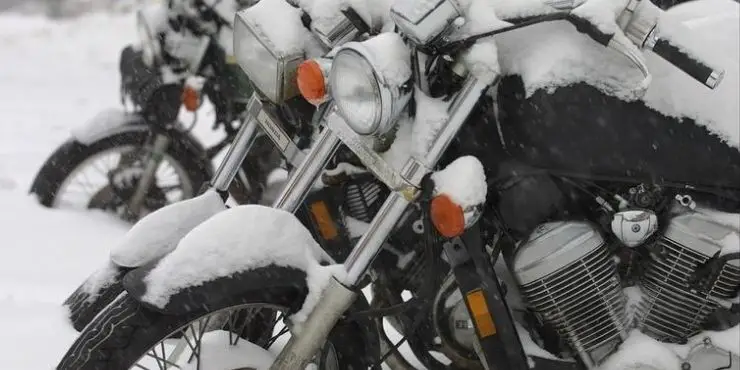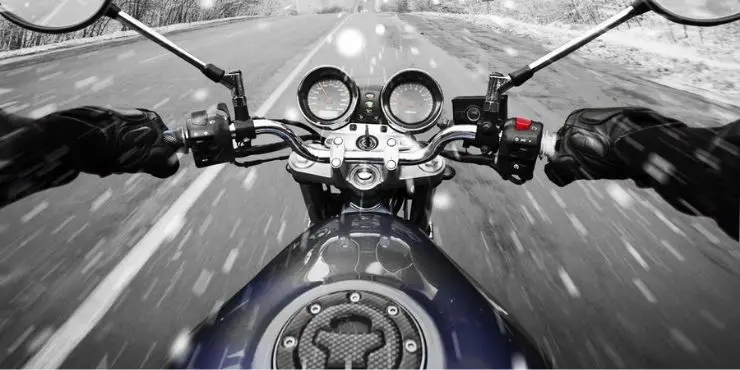Has it ever been too chilly outside, and you’ve wondered is it too cold to drive your Harley-Davidson bike? If so, then you’re not alone. Every Harley-Davidson biker has probably thought of this question.
Riding becomes challenging and potentially unsafe below 32°F (0°C), as cold temperatures can affect tire grip, reduce rider dexterity, and increase the risk of ice on the road.
In this article, you’ll get to know all about when is it too cold to ride a motorcycle, what happens if you drive in winter, the important tips to keep in mind, and a lot more. Continue reading to know all about it.
When is it too cold to ride a motorcycle
“When is it too cold to ride a motorcycle” is something that every biker living in areas with extreme cold thinks about at least a couple of times per year. This is more of a situational thing and has to do more with your comfort level and preferences. However, there are a few general rules and safety guidelines that you must keep in mind.
Generally, it isn’t recommended that you should ride a Harley-Davidson bike if the temperature is below 32 °F or 0 °C. Below the freezing point, ice will start forming and bikes are far more susceptible to ice as they’re smaller vehicles. In case you must drive despite the low temperature, you should ensure that you’re wearing the proper gear.
Unless it’s unavoidable and absolutely necessary, it isn’t recommended that you drive your bike in extremely cold or harsh conditions. During such conditions, you’ll be at risk of hitting the ice, sliding or getting into accidents. However, riding a bike in such weather isn’t impossible. You just need to be a lot more careful and follow the important tips that’ll come later in the article.

Air temperature vs. Ground temperature during winters
During the winter months, especially when it is extremely cold, monitoring the air and ground temperature will be very important. Both of them can be quite dangerous for different reasons and should not be taken for granted when you’re driving. Riding a Harley-Davidson bike when the air temperature is below freezing point will be very dangerous. It’ll be even more dangerous if you’re not wearing proper gear, as hypothermia will set in very quickly. Human bodies have a natural temperature of 37 °C or 98.6 °F. In case this temperature drops below 35 °C or 95 °F, hypothermia will start kicking in.
As you’re driving in cold air, the air will constantly take away heat from your body. In fact, the heat will be taken away at a much faster rate than your body is able to produce it. Your internal temperature will keep getting lower and lower. You shouldn’t drive if the air temperature is below freezing point. Firstly, it won’t be enjoyable at all. Wouldn’t you rather want to be in a warm sweater or in your cozy quilt at home? Or would you want to be on the road, trying to keep your Harley-Davidson bike away from any icy patches?
It is also important that you monitor the ground temperature before you go outside. If there is any standing ice or snow on the road, it isn’t recommended that you should ride your bike. You will always find that there are tons of horrific motorcycle accidents during winters.
In fact, a study concluded that there were more accidents during winters because of snowy and slippery surfaces than at any other time of the year. If the ground temperature goes below freezing point, you shouldn’t go out and drive your Harley-Davidson bike. When you’re driving and it is raining or snowing, it’ll almost instantly freeze once it settles on the road. This will result in very dangerous riding conditions.
In many regions, the most dangerous part about driving in the winter season is the phenomenon called “black ice”. This will happen if the temperature stays below 0 °C for days. This will lead to the ice on the road getting compressed more and more. It’ll be nearly impossible to see, and you won’t be able to immediately turn your bike sideways to avoid it.
Understand the limitations when driving in cold weather
One of the biggest factors that you need to consider when thinking of riding in the cold is understanding your limitations and the limitations of your bike. Listen to that voice inside your head trying to tell you something. If you’re already debating with yourself whether you should go or is it too, then the answer is clear. Always look to be on the safe side and avoid going out and driving in unsafe conditions. You can always wait and go the next day.
If you’ve never driven your bike in extremely cold conditions and you wish to get some practice, then stick to back roads and go slow. It would be similar to riding a bike for the first time. Learning to drive in cold conditions will take a lot of practice and experience. You shouldn’t go out riding in cold conditions for hours unless you have great winter riding gear. As mentioned above, hypothermia and frostbite will start quickly when riding as the cold air will rush back to you.

Make sure that you understand the limitations of your bike. Many Harley-Davidson bikes are going to spit and sputter, as they don’t run well in the cold. You must take such things into account when you’re deciding whether you’re going to venture outdoors during extreme cold. If your bike has slick tires, then you shouldn’t ride below freezing temperatures. Slick tires will not ride well on ice while the rubber will become even harder and grip less in the cold. Ensure that you get tires with a more aggressive tread if you wish to ride outdoors in the cold.
If you must go out, proper gear will be mandatory
A leather riding jacket will offer the most protection from potential accidents. However, it isn’t the best choice when you’re riding outside during extreme cold. If you’re going to wear a leather jacket, ensure that you are wearing a long sleeve shirt underneath. It will give far better isolation. A better option would be to wear a winter riding jacket.
Remember that you never ride your bike in cold weather without wearing full-finger gloves. Your fingers would freeze within a matter of minutes and your response time will slow down too. You may think that you’ve driven a few miles and you don’t need gloves, but you’re wrong. After a while, you’ll notice that your hand has completely frozen and you aren’t able to pull the clutch handle.
When you’re riding in temperatures below 50 °F or so, it is recommended that you should wear thermal war. It is recommended that you should wear thermal underwear under your jeans, as it’ll keep your legs warm. Riding a Harley-Davidson bike with cold legs will be miserable. The cold air will make your legs cold and cramped up, and you’ll be stiff. Proper riding boots need to be worn whenever you’re riding a bike in extreme cold. You should prefer wearing the same pair of boots and ensure that they’re waterproof.
More important than the choice of boots will be the choice of socks. There are a lot of great choices for socks that are inexpensive and they’re still very good.
You can also use an anti-fog spray. An anti-fog spray will come cheap and you’ll be able to ensure that your breath isn’t fogging up the visor. Fogging visors will be incredibly annoying and dangerous when you’re driving. Once it begins, it’ll be almost impossible to clean and keep going. It will keep on fogging right back and you’ll be at risk of accidents.
Key safety tips to remember when you’re driving in extremely cold weather
1. Check the weather forecast before heading out
You shouldn’t underestimate how pivotal it can be to check the weather forecast. You need to know if it’ll be raining or snowing outside so that you can avoid heading out. The raindrops will freeze almost instantly, causing it very tricky to balance and drive safely. Even if the weather seems mild, the ice patches formed overnight could harm your driving experience.
2. Consider the braking distances
For a driver traveling at 30mph with a 210 kg motorcycle, the typical thinking distance will be 9 meters. Meanwhile, the braking distance will be 14 meters, which will make a total stopping distance of about 23 meters.
During winters, the braking distance will increase a lot. For combining this, you should increase the distance to the vehicle in front. Moreover, check your lights regularly and use more rear brake and engine braking in wet, slippery conditions.
3. Check your motorcycle’s condition before traveling
During extreme cold, it is important that you check your bike’s TCLOCs. Inspect these components before you start driving. TCLOC stands for Tyres, Controls, Lights, Oil, and Chassis.
Additionally, you should keep these things in mind –
- Clean and lubricate your Harley-Davidson motorcycle’s drive chain regularly, or you could wreck it in one ride.
- Check that your bike is rolling freely without any resistance.
- Older models that have carburetors may need some warming up with the coke on before you start driving. Meanwhile, most modern fuel-injected Harley-Davidson bikes can be driven straight away.
When starting your bike, if you haven’t used it for a while, let the engine warm-up for a while. Let it warm up for a few minutes before you rev it up. The best practice would be to get your motorcycle to normal operating temperature before you start the journey.
4. Be aware of the wind chill
A thermometer might tell you the ambient temperature, but it won’t consider the chill factor. The wind chill is what the temperature feels like and it will take into account wind strength, air temperature, and relative humidity.
For drivers, wind strength will be of particular importance. For instance, if you’re traveling at 20mph, the ambient temperature might be 0 °C, but the wind chill could be -6 °C.
Conclusion
Thank you for reading. Hopefully, now you know a lot more about riding a Harley-Davidson bike in cold, when is it too cold to ride a motorcycle, and the key tips to keep in mind. Generally, it’s advised that you shouldn’t ride a Harley-Davidson bike if the temperature is below the freezing point (i.e. 32 °F or 0 °C). At such temperatures, ice will start forming on the bike as bikes are comparatively smaller vehicles. Further, ice patches will start forming on the road and it’ll leave you at risk of accidents.

